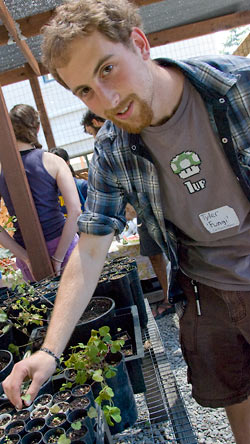Lots of sweat, not to mention vision and persistence, went into the creation of a sturdy wooden structure behind Giannini Hall, where on May 4 enthusiastic students and supporters celebrated the launch of the Strawberry Creek Native Plant Nursery.
An incubator for hyper-local native plants, the 36×16-foot nursery, financed by students via The Green Initiative Fund, became a reality thanks to a “vibrant and passionate movement to preserve and restore Strawberry Creek,” Tim Pine of Environment, Health and Safety (EH&S) told visitors at Wednesday’s grand opening.
Inside the nursery, David Pon, coordinator of native-plant activities for the Strawberry Creek Restoration Program (SCRP), showed off small green starts — cow parsnip, lupine, yarrow and more — that began as seeds or cuttings harvested from Strawberry and Claremont canyons. Once established, the young plants will be used to repopulate three designated natural areas alongside Strawberry Creek.
“Our goal is to restore the native California ecology, bringing it back to more historical ecological functions,” Pon said.
A no-less-important mission is to share with Berkeley students and others the whys and hows of biodiversity and native-plant restoration, say Pon and his fellow SCRP coordinators.

Student Tyler Grinberg
“The way to fix the creek and restore biodiversity is through education — so that wherever students are, on their own in the world, they’re stewards of the environment,” emphasized student Tyler Grinberg.
It helps to have an established infrastructure. Now — with a nursery, an adjoining demonstration garden-in-progress, and a pair of student-taught DeCal classes on Strawberry Creek restoration — students have good places to spread the restoration gospel and recruit converts for labor-intensive projects.
“Lots of students don’t even realize there’s a creek on this campus — how it’s been taken over [by invasives] and what steps are needed to restore it,” noted sophomore Katherine Blair. Once they’re exposed to the issues, many are eager to help, she said.
Many hands, lighter work
Ridding a river bank of invasive plants is not for the faint of heart. It takes strenuous digging and lopping to remove Chilean red currant, said SCRP’s Courtney Hann. Faced with a thick bed of English ivy, she added, volunteers have learned to uproot the tenacious invasive, then work shoulder to shoulder, pushing leaves and roots into a giant burrito-shaped roll.
“It’s easy with a lot of volunteers,” Hann said. “I’m really surprised how much ivy they’ve pulled and how many plants they’ve put in!”
Before restoration work began, the Grinnell Natural Area, near the intersection of Center and Oxford streets, was a “foreboding jungle” of ivy and a haven for nefarious activities, noted Pine. Crews of volunteers changed that. Over time, worker bees from campus, Berkeley High and the local community have replaced invasives with well over a thousand plant specimens representing 60 native species.
Students are currently transforming the Goodspeed Natural Area adjoining Faculty Glade. Also under restoration are the Wickson Natural Area, on the creek’s north fork between Giannini and Wellman halls.
The long view
Visitors and volunteers welcome!
While the Strawberry Creek Native Plant Nursery is open to visitors at most times, Sundays from 2 to 4 p.m. are devoted to free sessions — “part grunt work, part education” on native plants and habitats, Pon says. “I like to include a learning aspect to make the work more meaningful to the volunteers.”
For more information, see the Strawberry Creek website.
It was a quarter century ago that scientist Robert Charbonneau, then a graduate student, “saw a creek in decline and in dire need of TLC,” said Pine. The watershed management plan he authored in 1987 has guided campus restoration efforts ever since — first, in the 1990s, to improve water quality, then to reintroduce native fish populations, most recently to restore the native habitat alongside the stream’s north and south forks.
For some time, replanting efforts were quite ad hoc, Pine said: EH&S staff were known to raise native seedlings on their window sills at work, or at home in their back yards. Sometimes natives were purchased from local nurseries.
“We realized we could collect seeds and cuttings from local habitats, bring them back to campus and grow them ourselves,” Pine recalled.
